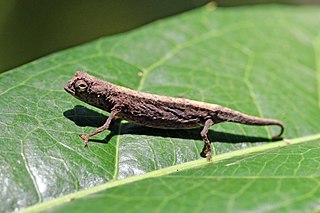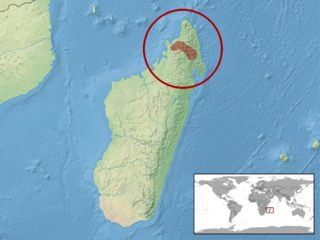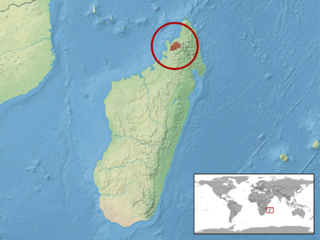
Brookesia is a genus of chameleons, endemic to Madagascar, that range from small to very small in size, and are known collectively as leaf chameleons. Brookesia includes species considered to be the world's smallest chameleons, and are also among the smallest reptiles. Members of the genus Brookesia are largely brown and most are essentially terrestrial.

The Antsingy leaf chameleon is a species of lizards in the family Chamaeleonidae. The species is also referred to as Armoured leaf chameleon.

Brookesia peyrierasi is a species of diminutive chameleon, a lizard in the family Chamaeleonidae. The species is endemic to north-eastern Madagascar. It is known commonly as Peyrieras's pygmy chameleon, named after the herpetologist André Peyriéras.

The Mount d'Ambre leaf chameleon is a diminutive chameleon from far northern Madagascar.

Brookesia minima,, is a diminutive chameleon that was regarded as the smallest lizard of the Chamaeleonidae until a smaller species, Brookesia nana, was described in 2021.

Brookesia ebenaui is a chameleon, a lizard in the family Chamaeleonidae. The species, which is endemic to Madagascar, can rapidly change color among various earth hues.

Brookesia micra, also known as the Nosy Hara leaf chameleon is a species of chameleons from the islet of Nosy Hara in Antsiranana, Madagascar. At the time of its discovery, it was the smallest known chameleon and among the smallest reptiles, until the 2021 discovery of the even smaller B. nana. Adult B. micra can grow up to 29 mm (1.1 in) in length.

Brookesia stumpffi, also known as the plated leaf chameleon, is a species of chameleon found in some parts of Madagascar. It can be found in Nosy Bé, north-west Madagascar, Nosy Komba, and Nosy Sakatia.

Brookesia decaryi is a species of chameleon, which is endemic to Madagascar, and is ranked as an endangered species by the International Union for Conservation of Nature (IUCN). It was initially described in 1939 by Fernand Angel. B. decaryi is commonly known as Decary's leaf chameleon, spiny leaf chameleon, or Decary's pygmy chameleon.

Brookesia betschi, commonly known as Blanc's leaf chameleon or the Marojejy leaf chameleon, is a species of lizard in the family Chamaeleonidae. The species is endemic to Madagascar.

The naturelle leaf chameleon is a species of chameleon, a lizard in the family Chamaeleonidae. The species is endemic to Madagascar. It was rated as an endangered species by the International Union for Conservation of Nature on its Red List of Threatened Species. The species was described by Édouard-Raoul Brygoo, Charles Pierre Blanc, and Charles Domergue in 1970.

Brookesia bonsi is a species of chameleons, a lizard in the family Chamaeleonidae. The species is endemic to Madagascar, and was initially described by Guy A. Ramanantsoa in 1980. The International Union for Conservation of Nature ranked this species as Critically Endangered.

Brookesia brygooi, commonly known as Brygoo's chameleon, Brygoo's pygmy chameleon, and the leaf chameleon, is a species of chameleon, a lizard in the family Chameleonidae. The species, which is endemic to Madagascar, was first described in 1995 by Raxworthy and Nussbaum and named in compliment to French herpetologist Édouard-Raoul Brygoo.

The toothed leaf chameleon, Brookesia dentata, is a species of chameleons endemic to northwestern Madagascar. It was first described by Mocquard in 1900: 345, and has been described numerous times since then, most recently by Townsend et al. in 2009. It is affected by the collection of charcoal, forest fires, and the grazing of cattle. Its holotype provides from Maevatanana (Suberbieville).

Brookesia therezieni, also known as the Perinet leaf chameleon, is a species of lizards in the family Chamaeleonidae. The species is endemic to eastern Madagascar. The International Union for Conservation of Nature (IUCN) classed the species as Least Concern. B. therezieni was initially described as a species new to science by Édouard-Raoul Brygoo and Charles Antoine Domergue in 1970.

Brookesia thieli, commonly also known as Domergue's leaf chameleon or Thiel's pygmy chameleon, is a species of lizard in the family Chamaeleonidae. The species is endemic to eastern Madagascar, with a type locality of Ambodimanga, Andapa. It was first described in 1969 by Édouard-Raoul Brygoo and Charles Antoine Domergue, and it was ranked by the International Union for Conservation of Nature as "least concern". B. thieli is thought to be found over an area of 43,865 km2 (16,936 sq mi) at 875–1,200 m (2,871–3,937 ft) above sea level.

Brookesia valerieae is a species of chameleon, a lizard in the family Chamaeleonidae. The species is endemic to Madagascar. It was first described by Raxworthy in 1991. The IUCN have classed this species as endangered, and it is affected by slash-and-burn agriculture. It is not a protected species.

Vences's chameleon is a species of lizard in the family Chamaeleonidae. The species is endemic to Madagascar.

The Iaraka River leaf chameleon, also commonly known as the mossy pygmy leaf chameleon, is a species of chameleon, a lizard in the family Chamaeleonidae. The species is endemic to Madagascar.

Brookesia nana, also known as the nano-chameleon, is a species of chameleon endemic to montane rainforests in northern Madagascar. Described in 2021, it could represent the world's smallest reptile. Unlike some chameleons, Brookesia nana does not change colors.






















